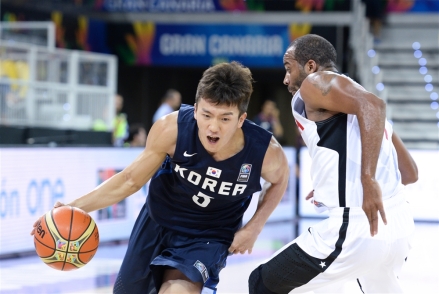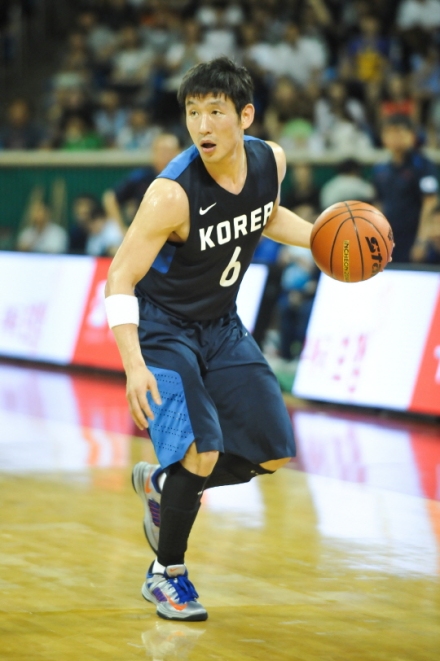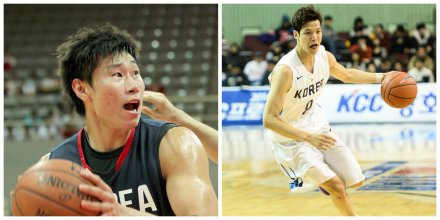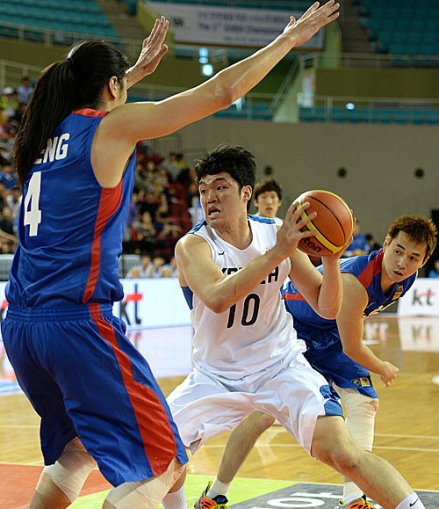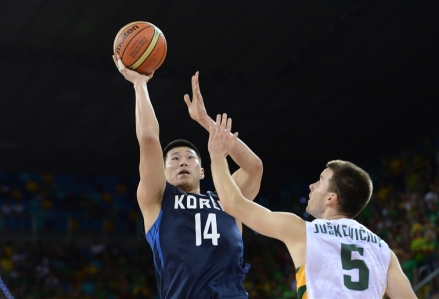In 2012 when Lee Sang-Beom was the head coach of the national team bound for the pre-olympic wildcard tournament in Venezuela, the decision to cut Lee Seung-Hyun was an easy one. The freshman from Korea University was still raw, his physique was underdeveloped for the senior’s game and the national team had abundance of big men standing above 6’9 including the 18 year old wunderkind Lee Jong-Hyun. Taking it as pointers, the freshman built his upper body strength, improved his conditioning and made progress in his low post game. In 2013 when Yoo Jae-Hak was the head coach of the national team, Lee Seung-Hyun was cut once again. Yoo pointed out that Lee had to work on his shooting despite already equipped with a back to the post game and a midrange drive. Once again, Seung-Hyun took it as a challenge. He practiced on his shooting from inside the arc and beyond, often staying late in the gym and shooting hundreds of jumpshots over the weekends. His work ethic was rewarded and shooting the jumper looked natural in his form. In 2014 when the national team was bound for the FIBA World Cup and the Incheon Asian Games, Seung-Hyun was again cut by Yoo Jae-Hak. Yoo cited that Lee needed more experience in playing against bigger and stronger opponents outside of college competition. Seung-Hyun was headed to the Korean Basketball League. He was picked first overall by the Goyang Orions and he quickly made an impact: leading all rookies in scoring, rebounds and assists. He was playing against foreigners much bigger and athletic than him but he thrived. He helped Goyang return to the playoffs and would be awarded as a co-rookie of the year alongside college rival Kim Junil from Yonsei, who was now playing for Samsung. When Lee Seung-Hyun’s name was again included in the national team playing pool, he made the most of his opportunity. He schooled veterans at times when taken to the perimeter. He showed strength in boxing out for the rebounds even against the 7-3 Ha Seung-Jin and has shown a complete game that had Kim Dong-Kwang speaking highly of the 23 year old in media interviews.

Lee Seung-Hyun has come a long way. Image courtesy of Newsis
When Lee Seung-Hyun was included for the William Jones Cup twelve man roster in the Jones Cup, his foot was at the door, he was finally going to make the senior’s national team; a dream he had been pursuing for years. In the Jones Cup, Seung-Hyun thrived. Going up against bigger players he was firm in the post an immovable object when he boxes out for a rebound. He was excellent in shooting the midrange shot and the three pointer during a pick and pop situation or the flank shooting setup. He shot 51% from the field and had the fewest turnover stat in the team.
After the splendid performance in the Jones Cup, Seung-Hyun more than rewarded Kim Dong-Kwang’s vote of confidence, he showed that he will be an essential player for many years to come, providing utility and efficiency in the screen game of big men in today’s uncanny game of big men further deviating from the post where it was once their essential field of operations.
Lee Seung-Hyun is just one of the young players that Korea will depend on for the foreseeable future under FIBA play as there is an air of change within its ranks as one can see in the list of the national team players for the FIBA Asia tournament in China later this month.
South Korea’s National Basketball Team for FIBA Asia 2015
Yang Dong-Geun (Ulsan Mobis Phoebus)
Kim Tae-Sol (Jeonju KCC Egis)
Moon Seonggon (Korea University)
Park Chan-Hee (Anyang KGC)
Cho Sung-Min (Busan Sonicboom KT)
Lee Jung-Hyun (Anyang KGC)
Choi Jun-Young (Yonsei University)
Moon Tae-Young (Samsung Thunder)
Lee Seung-Hyun (Goyang Orions)
Kang Sangjae (Korea University)
Kim Jong-Kyu (Changwon LG Sakers)
Lee Jong-Hyun (Korea University)
In May, Yang Dong-Geun said in an interview that this could be his last tour of duty with the national team. The spitfire of a point guard has won several championships including three consecutive ones with Ulsan while he has lead Korea back to the world cup and an Asian games gold medal. Other veterans such as the sharpshooting Cho Sung-Min and playmaker Kim Tae-Sol have also paid their dues for the national team, often incurring injuries as a proud mark of being battle-scarred.

Kim Tae-Sol us just as important for the national team. Image courtesy of J&J Media
As the veterans are due to retire from the national team, the young ones are accumulating experience as they will be the pillars of Korea’s future. The formula of adding young players into a team lead by veterans has been the national program’s success of the years. Continuity and succession means the national team is a potent mix of veterans and upstarts. Kim Jong-Kyu formerly of Kyung-Hee is the next in line of being the epitome of essential for the national team. Since joining the program in 2009 and breaking through the senior’s competition in 2010, Kim Jong-Kyu has since progressed from a backup utility role of adding an extra body into the fold to a vital cog of the machinery. His ability to play power forward and center including the soft touch from the perimeter highlights the next evolutionary step of Korea’s big man where it traced its origins from Seo Jang-Hoon, Chun Hee-Chul and Kim Joo-Sung. Kim Jong-Kyu has been mentored by Kim Joo-Sung since 2012 where the veteran has passed on lessons and advice like one from teacher to student and it is paying off.
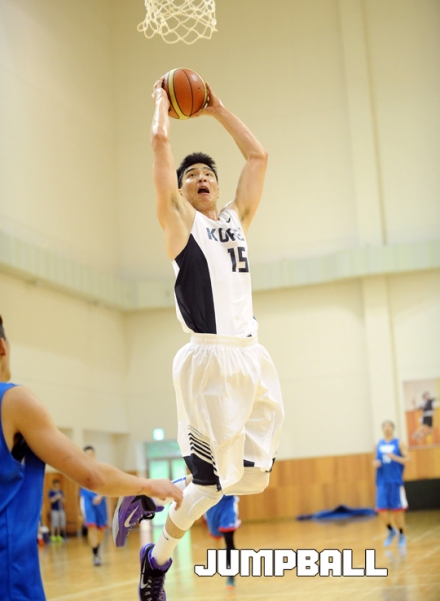
image courtesy of Jumpball
The young man was at his finest during last year’s Asian games gold medal game against Iran, often taking Hamed Haddadi into the perimeter where Jong-Kyu scored most of his points through midrange jumpshots. When Korea won the gold medal, the torched was passed on. Kim Jong-Kyu thrived while Kim Joo-Sung had step aside in letting the big man take his flight. Entering the FIBA Asia competition in China later this month, the national team will be without Kim Joo-Sung, treading uncharted waters with a new rudder.

Lee Jong-Hyun and Kim Jong-Kyu. Image Courtesy of Jumpball
Kim Jong-Kyu’s partner is Lee Jong-Hyun another 6’9 young big man that has an emerging perimeter game with a defender’s mentality equipped with a seven foot wingspan and impeccable timing for shot blocking. That combination helped Jong-Hyun lead the world cup in blocks per game during the first round. What was impressive is that his defense was felt in not only plus and minuses of the cumulative statistics but also how he would alter shots with his effort as he flashed potential of becoming Asia’s shot-blocking terror being nurtured against the teams from across the globe. The world cup experience, Asian games gold and the lack of competition in college ball made him eventually declare for the 2015 NBA Draft. Assessing his progress from being an eighteen year old high school prospect called into the ranks of the senior’s squad to being Korea’s future big man, Jong-Hyun made the leap. “I want to challenge that [ NBA ]dream,” Jong-Hyun was quoted by Naversports. Lee hired an agent based in Chicago and flew to the United States after finishing a compacted military service enlistment in which that commitment had prevented him from attender pre-draft workouts in Chicago.
To no one’s surprise, Lee Jong-Hyun went undrafted but was hopeful for an invitation from NBA teams to play in the NBA Summer League. Lee worked out every day but the invitation never came and he decided to return to Korea and try his luck next year. There were reports that Jong-Hyun will enter the KBL 2015 draft that will make him the automatic top pick but nothing is yet set in stone. The young man eventually rejoined the national team in Taiwan for the Jones Cup, making the most of his starts. In the last three games, Jong-Hyun averaged 15 points, 7 rebounds and 2 blocks per game. He started the tournament as a backup center to the 7-3 Ha Seung-Jin. There were situations where Jong-Hyun worked in tandem with Kim Jong-Kyu and the two displayed chemistry that is a product of being teammates with the national team since 2012. Korea’s twin tower was in display and the tandem will still have many years to work together where Lee Jong-Hyun will play center, assuming the role of the defensive anchor while Kim Jong-Kyu is the finesse power forward, a role long held by mentor Kim Joo-Sung where Jong-Kyu is expected to score, rebound and defend as the team’s essential player.

Lee Jong-Hyun tried his luck in the NBA Draft after the FIBA World Cup. Image Courtesy of FIBA
After arriving from the William Jones Cup, there were dark clouds hovering above the national team and it will grow into a storm. First was the injury to Ha Seung-Jin, who broke down in the final games in the Jones Cup tournament. A hip strain, a hamstring pull and soreness in the knee would see the big man going down from participating in China. Two days before leaving for Taiwan, Yoon Ho-Young suffered a late injury that would rule him out. Korea was set to play with an eleven man squad. In the tournament, Yang Dong-Geun could not play as he battled Achilles tendinitis and he would not play in any game for the sake of preserving him for the Asian qualifiers. Korea played with a ten man rotation that soon became a nine man lineup as Seung-Jin went down.
As the team was reeling from injuries the dark clouds hovered above soon became a storm, the match fixing allegations that has been a problem for Korean professional sports has struck its treacherous ways. Seoul SK’s Kim Sun-Hyung was the first star to be mentioned over possible involvement with match fixing. Kim was out of the program as the case as investigations were ongoing and prosecutors readying charges. Sun-Hyung has been associated with the national team since 2009 and eventually stepping into the senior’s ranks in 2012. His display of energy, speed and athleticism had him reputed as the successor to Yang Dong-Geun. With the ball, he was a track star, often leading the break and finishing with a breakaway dunk, something unprecedented in Korea. He was the emerging sixth man with his fire starter attitude, being deployed as a weapon in using speed as a tactical advantage against bigger and less mobile teams – evident in his 24 point game against Russia in the Jones Cup where all his points were in the second half. It was a game reminiscent of his debut game against the Dominican Republic in 2012 where his highlight was a dunk from finishing the fastbreak that he started. Since 2012, Kim Sun-Hyung was considered as an emerging superstar in Korea that many saw as another essential piece for the future. With his alleged involvement in the match fixing ring, that star may be lost – if proven guilty was it will warrant a lifetime ban in both the national team and the KBL.

Image courtesy of FIBA
Another big name was dragged into the black hole that is the match fixing problem. It was former champion and league MVP Oh Se-Keun is considered as the foundation of Anyang KGC. The former Chung-Ang star was a first pick overall and from 2008, has been a member of the national team as a tremendous contributor. His motor, physique and athleticism powered his scrapper game, often doing the dirty work to get things done. Se-Keun rebounded, hustled and provided so many second chance points and possessions to the national team. He has earned the mantle of the team’s blue chip player with his workhorse approach in the game. In missing duties for the national team in 2013, his absence was felt. Se-Keun would return in 2014, helping the team in 2014’s FIBA World Cup campaign and in capturing gold in Incheon. This summer, he was called up to the national team but was left out of the Jones Cup team due to a problematic ankle. Although left out, Se-Keun was not cut and he was permitted to practice with his club. Kim Dong-Kwang was hopeful that Se-Keun would get healthy after the Jones Cup for him to rejoin the national team for FIBA Asia. It never came.

Image courtesy of FIBA
Reputations are made over time, but reputations are also destroyed in one instance. He and his former college teammate Kim Sun-Hyung are currently out of the national team and suspended from all KBL participation as the case is ongoing. If proven guilty, a lifetime ban in participation with the national team and professional basketball is to be expected.

image courtesy of J&J Media
For two years straight, the national team has suffered from controversy. Last year, Jeonju KCC Egis breakout star Kim Min-Goo’s career was derailed due a vehicular accident while driving under the influence of alcohol. Min-Goo would be hospitalized and semi-paralyzed. Questions of discipline for professionals were in question for the national team’s governing committee. Min-Goo’s accident lead to a strict curfew while under the national team and for the youth players participating in the seniors, a “guardian” system was instilled where seniors are tasked to bunk in with the younger players, setting a formative conduct to follow. This year, the KBL’s reputation is once again tarnished with several of players including Kim Sun-Hyung and Oh Se-Keun are being probed for alleged match fixing. For two seasons, the KBL has instituted reforms and handed out stiff penalties to active and retired players and coaches who are found guilty of participating in the illegal gambling for the sport. Despite the KBL’s efforts match-fixing is still rearing its ugly head as a tarnishing agent to the league.
Despite off-court troubles, South Korea’s national team pushed on. Replacements were called up from the college rank to fill in for the missing personnel. Korea University’s Moon Seonggon and Kang Sangjae have been call up to join teammate Lee Jong-Hyun and alumnus Lee Seung-Hyun. Yonsei’s versatile forward Choi Jun-Young was also called up as reinforcement in the wings. All three have played in the youth competitions for Korea’s U18 and U1 squads. Moon Seonggon and Choi Jun-Young have in fact played for the national team in the 2013 FIBA Asia World Cup qualifiers that was held in Manila. Despite playing limited minutes, both accounted the tournament for experience where they have since elevated their game in collegiate competitions. Both were cut from the national team in last year’s quest for the Asian games gold as Yoo Jae-Hak then wanted veterans in Yang Hee-Jong and Jeong Young-Sam as the team’s imperative was to win at home where veterans have a higher probability of success compared to youth and its inexperience in nerve wrecking moments when the game is on the line.
Age is relative
This year, the paradox of age is the consequential factor of this team’s success or failure. This team is a blend of veterans in their last legs. The additions of younger players who are yet unproven contributors when it all matters will make or break the team when the competition escalates in China later this month. Yang Dong-Geun, Cho Sung-Min, Kim Tae-Sol and Moon Tae-Young are already in their thirties and will need to pass on the baton. The back-court of Yang Dong-Geun and Cho Sung-Min has been a fixture for Korea since 2010. The duo’s combined offense has made this team dangerous but this year, the duo is showing signs of their age from wear and tear. The once reliable motor from Yang Dong-Geun as a scoring pace setter and the deadly sniping from Cho Sung-Min are starting to sputter with health issues. Given their history of playing through injuries, Korea can muster it up one more time. This is the time for the youth to step ahead when veterans are unable to perform.

With the addition of Moon Seonggon, Choi Jun-Young and Kang Sangjae, the team has certainly gone younger and has replenished not only personnel but also addressed the health issues of unavailable members in Yang Hee-Jong and Yoon Ho-Young. But there is no guarantee if these young men will break through the pressure and play well or deflate a bit when the games come down to win or lose situations where split second mistakes will have game ending consequences. Among the youth that Korea contains, only Kim Jong-Kyu and Lee Jong-Hyun have played in levels where pressure is paramount. Lee Seung-Hyun, despite his improvement will still need to be proven in this test of fire as the Jones Cup and preparatory games does not simulate the pressure associated with the FIBA Asia qualifying tournaments. The same applies for Moon Seonggon, Choi Jun-Young and Kang Sangjae where time will tell if they rise above the pressure and perform or will their inexperience be a factor in the tense elimination games. Kim Min-Goo in 2013 rose above the challenge where he was a revelation for the team in Manila. He alongside Kim Jong-Kyu, Lee Jong-Hyun, Choi Jun-Young and Moon Seonggon were supposed to be the future of Korea. With both Min-Goo and Kim Sun-Hyung out, someone must step up and provide scoring or make a difference when the team needs it. Moon Seonggon and Kang Sangjae must find his range and start hitting shots when called upon. Choi Jun-Young must also not disappear when his shots are not falling. With Yonsei, Choi has provided the team with his rebounding, defense and playmaking that made his team the number two favorite behind Korea University. Somehow, Choi must elevate those contributions into FIBA Asia.
Moon Tae-Young aka Gregory Stevenson is the naturalized player for South Korea, taking up the lofty status from his older brother Moon Tae-Jong aka Jarod Stevenson. The older Moon has helped the team finish third in 2011, played in the world cup in 2014 and was a celebrated hero in Korea’s conquest of the Asian games gold medal. Tae-Young is no spring chicken as the 37 year old forward still has enough left in the tank to help Korea in their Olympic campaign. His years with revitalizing the Changwon LG Sakers into the playoffs and helping Ulsan Mobis Phoebus win three consecutive championship through his dynamic offensive skills is what older brother Tae-Jong provided Korea. The younger brother hopes to live up to the lofty standards set by the older brother. “It’s been my dream to play for the national team. Jarod told me to make the most of it,” said the younger Moon in an interview with Donga. In 2013, it was Lee Seung-Jun aka Eric Sandrin that got the nod as the naturalized player for Korea that was bound for Manila. This year’s FIBA Asia could mark the first time and last time that Tae-Young suit up for the national team as he may step aside for the younger players and rest in the succeeding summer to help Samsung in their quest for revival.
Depth Chart
PG – Yang Dong-Geun, Kim Tae-Sol, Park Chan-Hee
SG – Cho Sung-Min, Lee Jung-Hyun, Moon Seonggon
SF – Moon Tae-Young, Choi Jun-Young
PF – Lee Seung-Hyun, Kang Sangjae
C – Kim Jong-Kyu, Lee Jong-Hyun
Alternate positions:
Lee Jung-Hyun and Moon Seonggon can play up to SF.
Moon Tae-Young and Choi Jun-Young can play up to PF.
Kim Jong-Kyu can slide down to PF
The Coach and his System
To run Kim Dong-Kwang’s dynamic flex offense players must be able to make decisions basing on recognition of their teammates position and reaction basing on who has the ball and who has the ability to draw up defenses to pass to an open man. The venerable mentor wants Korea to rediscover their form from the South Korean teams of old that was known for ball movement, precision in passing and the deadly outside shots. Given the modern game, the flex is capable in operating with a tall or small lineup so long as the personnel are all able to dribble, pass and shoot. The ingredients are set and only the recipe remains.

image courtesy of newsis
Kim Dong-Kwang was not supposed to coach the national team. He was approached and named as the Asian qualifiers was in conflict with the start of the KBL season. Ulsan’s Yoo Jae-Hak and Incheon’s Yoo Do-Hoon were committed in commanding their teams. The KBA needed a coach who was not affiliated with a KBL team. Of the names proposed such as Hur Jae, Lee Sang-Beom, Choi Boo-Young, Kim Dong-Kwang got the nod. A few days after his appointment to call the shots for the national team, he worked with the selection in committee in selecting the players that will comprise of the 24 man player pool that will be the basis of selection and will be passed on to FIBA. He handpicked the veterans and a number of young players from the collegiate ranks.
Fast forward into training camp, Kim explained his vision, citing the Korean teams of old as an inspiration for this year’s national team. Then he explained the flex in which a couple of KBL players have experienced in running namely, Kim Tae-Sol, Park Chan-Hee, Lee Jung-Hyun and Oh Se-Keun when they were teammates under Anyang KGC. Kim Jong-Kyu, when he was still playing for Choi Bo-Young in Kyung-Hee. Lee Jong-Hyun, Kang Sangjae and Moon Seonggon are also running the flex in Korea University. As he picked the personnel, the criteria was familiarity of the system and when the sixteen players were drafted into advance training camp prior to the Jones Cup, the majority of the players knew the flex.
With the dynamic flex, the point guards were the key to set up the angle and spot of the screens that was to exploit gaps in the offense. Surveying the opposing defense, a high screen will be called up as a way to start either the dribble entry situation or use it as a feign to skip pass into an open shooter when the defense does close and show up in the screen. During that scenario, a second side screen in the far post of the strong side will be happening in succession to either free up a shooter off a curl or the screening big man to be open for a jump shot or make a sharp roll underneath the basket. It has variations where instead of a dribble entry screen working with one another, the guard can set up a quick arc reflex by passing to an open shooter by the side corners followed by a twisting screen to either drive or use it as a skip pass towards a shooter in the high arc or at the high opposite corner. When closed out by the defense, the shooter must quickly pass it to trigger either a 1-2 length passing or a 1-2 IO passing to free up either another shooter or get another cutter open underneath a basket.
One rule of thumb under the flex is the split second decisions to either pass, dribble towards the exposed gap or shoot the ball in order to not let the defense get set and play the passing lanes with active anticipation. For the players who have played under Yoo Jae-Hak’s uptempo Mike D’Antoni like offense from 2013 to 2014, this is a challenge to get adjusted to. Against their first game with the visiting Chinese Taipei team, the national team was playing in an unsustainable pace to execute the flex, the result was mostly errors and turning the ball over to the standby defenders. Against Iran in the Jones Cup, the team had the mentality to speed up the tempo, hoping to offset Iran’s size just like what they did in the Asian games gold medal game. Again, the uptempo proved to be their undoing as Iran managed a lot of turnover to points due to sloppy passes. Only when the team learned to play in a controlled pace is when they managed to execute better and for the team to shoot at a higher percentage. The only time they can run the uptempo is when the ball is intercepted and the player who stole the ball can make an attempt for a fast-break. With the weeks leading to the Asian qualifying tournament in China, Kim Dong-Kwang is hoping to further tweak his rotation and defensive setups to counter the bigger players of China and Iran.
Ha Seung-Jin is still a factor
Last year, Yoo Jae-Hak tested the waters of Ha Seung-Jin’s inclusion to the world cup bound national team but Seung-Jin’s conditioning was not ideal. After a full season in the KBL and recovering from a nasal fracture the 7’3 center was ready to rejoin the national team just like his younger days. Ha Seung-Jin in training camp presented a challenge for Kim Dong-Kwang. The 7-3 center was slow and is primarily a post operator compared to the younger big man in the team. But Kim was determined to make it work. Seung-Jin was subject to early morning and late afternoon conditioning exercises form cardio and flexibility to make him into a screen and roll bigman, using screens and catching the ball during a motion for easy points. The presence of Seung-Jin gives Korea a seven footer as a ceiling to match China and Iran. Seung-Jin’s presence allows LG’s Kim Jong-Kyu to play power forward where his finesse skill such as shooting is ideal. Ha Seung-Jin in the national team sets Lee Jong-Hyun as a backup or the primary option before Seung-Jin and that sets Korea’s center rotation at a solid state. This is also applicable to Seung-Jin’s absence where Kim Jong-Kyu and Lee Jong-Hyun must alternate at the center spot.

With Ha Seung-Jin injured and out of commission, Korea’s big men of 6’9 Kim Jong-Kyu, Lee 6’9 Jong-Hyun, 6’7 Lee Seung-Hyun and 6’8 Kang Sangjae will have to hold their own against China’s seven footers in Wang Zhelin, Zhou Qi, Li Muhao and Yi Jianlian. They must steel themselves against the rough and tough Iranian front-court lead by Hamed Haddadi. The Philippines will also feature Andray Blatche, who was not eligible for the Asian Games due to the Olympic Council of Asia’s four year residency rule. With Blatche as the naturalized player alongside the strong front-line of Paulasi Taulava, Sonny Thoss and the tenacious Marc Pingris, Korea’s young front-line will face an acid test.
Korea’s strength: Shooting
All twelve players for South Korea can shoot the long ball. Lee Jong-Hyun has been working on his shooting range. New additions Lee Seung-Hyun and Kang Sangjae are reputed stretch fours for Korea University. Lee Jung-Hyun shot 7/7 in their final game against Chinese Taipei. While Cho Sung-Min shot poorly in the Jones Cup, unable to hit the threes that he used to hit with remarkable accuracy, Korea is hoping that Cho finds his rhythm as the number one curl shooter out of the screens.
Winds of Change
For many of the veterans that was with the national team in last year’s Asian gold campaign, it marked the swan song for them to sail away, armed with the hardware to forever cherish. That team reached the pantheon of the legendary 2002 Busan Asian games gold medal winning team. After their moment in the sun, the likes of Kim Joo-Sung, Moon Tae-Jong and Jeong Young-Sam have retired from national team duties. With Yang Dong-Geun, Cho Sung-Min, Kim Tae-Sol and Moon Tae-Young all in their thirties, 2015 could also be their final participation.

Yang shoots over a defender
It is time for Korea to move on and start a new chapter and a new generation of players who will endeavor to represent the country with pride and zeal. Although winning in China is the aim, the odds are less favorable compared to last year’s Asian Games. However, finishing second is also a steep climb while aiming for third and fourth are reachable given Korea’s 2011 and 2013 third placed finishes. The runner-up, the third placer and fourth placer will qualify for next year’s pre-olympic wildcards. Similar in 2011 when Korea finished third, they used the 2012 Venezuela pre-olympic wildcards as a staging ground to launch the careers of Lee Jong-Hyun and others. A second, third or fourth placed finished will allow them to introduce younger players into the national team once again.
Take a good look at this team and appreciate the veterans who are on their final chapter. Also take note of the young ones as they mark a new chapter in Korea’s seldom discussed basketball success despite all the troubles in its basketball league. The sport of basketball has been resilient in Korea and it will continue to do so.
